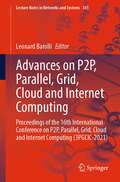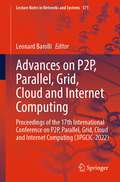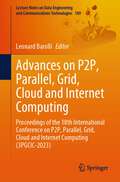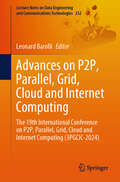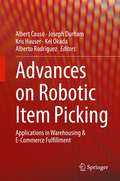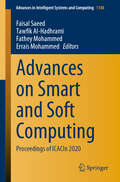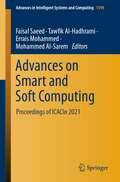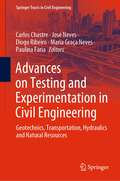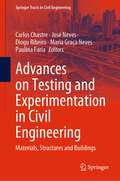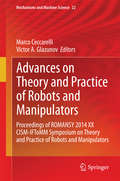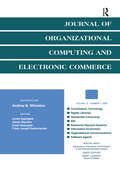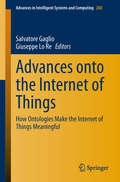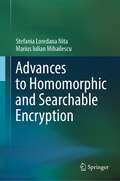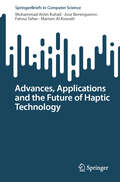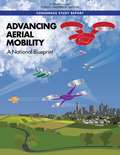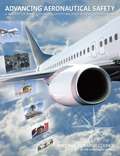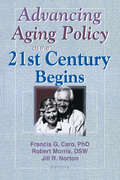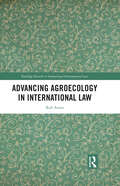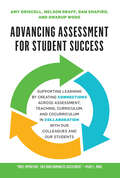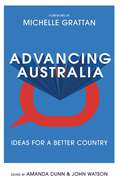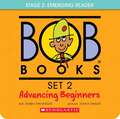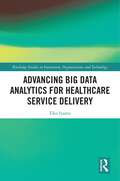- Table View
- List View
Advances on P2P, Parallel, Grid, Cloud and Internet Computing: Proceedings of the 16th International Conference on P2P, Parallel, Grid, Cloud and Internet Computing (3PGCIC-2021) (Lecture Notes in Networks and Systems #343)
by Leonard BarolliThis book provide latest research findings, innovative research results, methods and development techniques from both theoretical and practical perspectives related to P2P, grid, cloud and Internet computing as well as to reveal synergies among such large-scale computing paradigms. P2P, grid, cloud and Internet computing technologies have been very fast established as breakthrough paradigms for solving complex problems by enabling aggregation and sharing of an increasing variety of distributed computational resources at large scale.Grid computing originated as a paradigm for high performance computing, as an alternative to expensive supercomputers through different forms of large-scale distributed computing. P2P computing emerged as a new paradigm after client-server and web-based computing and has shown useful to the development of social networking, Business to Business (B2B), Business to Consumer (B2C), Business to Government (B2G), Business to Employee (B2E) and so on. Cloud computing has been defined as a “computing paradigm where the boundaries of computing are determined by economic rationale rather than technical limits.” Cloud computing has fast become the computing paradigm with applicability and adoption in all application domains and providing utility computing at large scale. Finally, Internet computing is the basis of any large-scale distributed computing paradigms; it has very fast developed into a vast area of flourishing field with enormous impact on today’s information societies serving thus as a universal platform comprising a large variety of computing forms such as grid, P2P, cloud and mobile computing.
Advances on P2P, Parallel, Grid, Cloud and Internet Computing: Proceedings of the 17th International Conference on P2P, Parallel, Grid, Cloud and Internet Computing (3PGCIC-2022) (Lecture Notes in Networks and Systems #571)
by Leonard BarolliThis book aims to provide latest research findings, innovative research results, methods and development techniques from both theoretical and practical perspectives related to P2P, Grid, Cloud and Internet computing as well as to reveal synergies among such large-scale computing paradigms. P2P, Grid, Cloud and Internet computing technologies have been very fast established as breakthrough paradigms for solving complex problems by enabling aggregation and sharing of an increasing variety of distributed computational resources at large scale. Grid Computing originated as a paradigm for high-performance computing, as an alternative to expensive supercomputers through different forms of large-scale distributed computing. P2P Computing emerged as a new paradigm after client–server and web-based computing and has shown useful to the development of social networking, B2B (Business to Business), B2C (Business to Consumer), B2G (Business to Government), B2E (Business to Employee) and so on. Cloud Computing has been defined as a “computing paradigm where the boundaries of computing are determined by economic rationale rather than technical limits.” Cloud computing has fast become the computing paradigm with applicability and adoption in all application domains and providing utility computing at large scale. Finally, Internet Computing is the basis of any large-scale distributed computing paradigms; it has very fast developed into a vast area of flourishing field with enormous impact on today’s information societies serving thus as a universal platform comprising a large variety of computing forms such as Grid, P2P, Cloud and mobile computing.
Advances on P2P, Parallel, Grid, Cloud and Internet Computing: Proceedings of the 18th International Conference on P2P, Parallel, Grid, Cloud and Internet Computing (3PGCIC-2023) (Lecture Notes on Data Engineering and Communications Technologies #189)
by Leonard BarolliP2P, Grid, Cloud, and Internet computing technologies have been very fast established as breakthrough paradigms for solving complex problems by enabling aggregation and sharing of an increasing variety of distributed computational resources at large scale.Grid Computing originated as a paradigm for high performance computing, as an alternative to expensive supercomputers through different forms of large-scale distributed computing. P2P Computing emerged as a new paradigm after client-server and web-based computing and has shown useful to the development of social networking, Business to Business (B2B), Business to Consumer (B2C), Business to Government (B2G), Business to Employee (B2E), and so on. Cloud Computing has been defined as a “computing paradigm where the boundaries of computing are determined by economic rationale rather than technical limits”. Cloud computing has fast become the computing paradigm with applicability and adoption in all application domains and providing utility computing at large scale. Finally, Internet Computing is the basis of any large-scale distributed computing paradigms; it has very fast developed into a vast area of flourishing field with enormous impact on today’s information societies serving thus as a universal platform comprising a large variety of computing forms such as Grid, P2P, Cloud, and Mobile computing. The aim of the book is to provide latest research findings, innovative research results, methods, and development techniques from both theoretical and practical perspectives related to P2P, Grid, Cloud, and Internet Computing as well as to reveal synergies among such large-scale computing paradigms.
Advances on P2P, Parallel, Grid, Cloud and Internet Computing: The 19th International Conference on P2P, Parallel, Grid, Cloud and Internet Computing (3PGCIC-2024) (Lecture Notes on Data Engineering and Communications Technologies #232)
by Leonard BarolliThis book aims to provide the latest research findings, innovative research results, methods, and development techniques from both theoretical and practical perspectives related to P2P, Parallel, Grid, Cloud, and Internet computing and to reveal synergies among such large-scale computing paradigms. P2P, Grid, Cloud, and Internet computing technologies have been very fast established as breakthrough paradigms for solving complex problems by enabling aggregation and sharing of an increasing variety of distributed computational resources at large scale. Grid Computing originated as a paradigm for high-performance computing, as an alternative to expensive supercomputers through different forms of large-scale distributed computing. P2P Computing emerged as a new paradigm after client-server and web-based computing and has shown useful to the development of social networking, business to business (B2B), business to consumer (B2C), business to government (B2G), business to employee (B2E), and so on. Parallel Computing is an essential computational paradigm for solving complicated problems quickly. It divides a scientific computing problem into several small computing tasks and concurrently runs these tasks by utilizing parallel hardware and overcoming the memory constraint. Parallel computing is an important part of cloud environment. However, there are significant differences between cloud computing and parallel computing. Cloud Computing has been defined as a “computing paradigm where the boundaries of computing are determined by economic rationale rather than technical limits”. Cloud computing has fast become the computing paradigm with applicability and adoption in all application domains and providing utility computing at large scale. Finally, Internet Computing is the basis of any large-scale distributed computing paradigms; it has very fast developed into a vast area of flourishing field with enormous impact on today’s information societies serving thus as a universal platform comprising a large variety of computing forms such as Grid, P2P, Cloud, and mobile computing.
Advances on Robotic Item Picking: Applications in Warehousing & E-Commerce Fulfillment
by Albert Causo Joseph Durham Kris Hauser Kei Okada Alberto RodriguezThis book is a compilation of advanced research and applications on robotic item picking and warehouse automation for e-commerce applications. The works in this book are based on results that came out of the Amazon Robotics Challenge from 2015-2017, which focused on fully automated item picking in a warehouse setting, a topic that has been assumed too complicated to solve or has been reduced to a more tractable form of bin picking or single-item table top picking. The book’s contributions reveal some of the top solutions presented from the 50 participant teams. Each solution works to address the time-constraint, accuracy, complexity, and other difficulties that come with warehouse item picking. The book covers topics such as grasping and gripper design, vision and other forms of sensing, actuation and robot design, motion planning, optimization, machine learning and artificial intelligence, software engineering, and system integration, among others. Through this book, the authors describe how robot systems are built from the ground up to do a specific task, in this case, item picking in a warehouse setting. The compiled works come from the best robotics research institutions and companies globally.
Advances on Smart and Soft Computing: Proceedings of ICACIn 2020 (Advances in Intelligent Systems and Computing #1188)
by Faisal Saeed Fathey Mohammed Tawfik Al-Hadhrami Errais MohammedThis book gathers high-quality papers presented at the First International Conference of Advanced Computing and Informatics (ICACIn 2020), held in Casablanca, Morocco, on April 12–13, 2020. It covers a range of topics, including artificial intelligence technologies and applications, big data analytics, smart computing, smart cities, Internet of things (IoT), data communication, cloud computing, machine learning algorithms, data stream management and analytics, deep learning, data mining applications, information retrieval, cloud computing platforms, parallel processing, natural language processing, predictive analytics, knowledge management approaches, information security, security in IoT, big data and cloud computing, high-performance computing and computational informatics.
Advances on Smart and Soft Computing: Proceedings of ICACIn 2021 (Advances in Intelligent Systems and Computing #1399)
by Faisal Saeed Tawfik Al-Hadhrami Errais Mohammed Mohammed Al-SaremThis book presents the papers included in the proceedings of the 2nd International Conference of Advanced Computing and Informatics (ICACIn’21) that was held in Casablanca, Morocco, on May 24–25, 2021. The main theme of the book is “Advances on Smart and Soft Computing.” A total of 71 papers were submitted to the conference, but only 44 papers were accepted and published in this book. The book presents several hot research topics which include artificial intelligence and data science, big data analytics, Internet of Things (IoT), information security, cloud computing, networking and computational informatics.
Advances on Testing and Experimentation in Civil Engineering: Geotechnics, Transportation, Hydraulics and Natural Resources (Springer Tracts in Civil Engineering)
by José Neves Diogo Ribeiro Carlos Chastre Maria Graça Neves Paulina FariaThe book presents the recent advances on testing and experimentation in civil engineering, especially in the branches of geotechnics, transportation, hydraulics, and natural resources. It includes advances in physical modelling, monitoring techniques, data acquisition and analysis, and provides an invaluable contribution for the installation of new civil engineering experimental facilities. The first part of the book covers the latest advances in testing and experimentation in key domains of geotechnics: soil mechanics and geotechnical engineering, rock mechanics and rock engineering, and engineering geology. Some of the topics covered include new developments in topographic survey acquisition for applied mapping and in situ geotechnical investigations; laboratory and in situ tests to estimate the relevant parameters needed to model the behaviour of rock masses and land structures; monitoring and inspection techniques designed for offshore wind foundations. The second part of the book highlights the relevance of testing and monitoring in transportation. Full-scale accelerated pavement testing, and instrumentation becomes even more important nowadays when, for sustainability purposes, non-traditional materials are used in road and airfield pavements. Innovation in testing and monitoring pavements and railway tracks is also developed in this part of the book. Intelligent traffic systems are the new traffic management paradigm, and an overview of new solutions is addressed here. Finally, in the third part of the book, trends in the field and laboratory measurements and corresponding data analysis are presented according to the different hydraulic domains addressed in this publication, namely maritime hydraulics, surface water and river hydraulics and urban water.
Advances on Testing and Experimentation in Civil Engineering: Materials, Structures and Buildings (Springer Tracts in Civil Engineering)
by José Neves Diogo Ribeiro Carlos Chastre Maria Graça Neves Paulina FariaThis book presents the most recent advances on testing and experimentation in civil engineering, especially in the branches of materials, structures, and buildings, complementing the authors’ publication Advances on Testing and Experimentation in Civil Engineering - Geotechnics, Transportation, Hydraulics and Natural Resources. It includes advances in physical modelling, monitoring techniques, data acquisition and analysis, and provides an invaluable contribution to the installation of new civil engineering experimental facilities. The first part of the book covers the latest advances in the testing and experimentation of key domains of materials, such as bio-cementation and self-healing, durability, and recycled materials, as well as the new environmental requirements related to the presence of hazardous substances in construction materials. Furthermore, laboratory and in situ tests, together with equipment needed to estimate the behaviour and durability of construction materials are presented, updating the most important technological advances. The second part of the book highlights the relevance of testing and monitoring in structures, including in situ tests related to static load tests, dynamic tests, and long-term monitoring strategies, as well as laboratory tests of adhesive joints. Experimental tests on shake tables and blast-resistant structures are also described. Recent applications of drone technologies for the inspection and monitoring of civil structures are another important theme developed. Finally, in its third part, the book presents new developments in the characterisation of building testing, with the support of modelling, to assess building pathology and new requirements, acoustic comfort, fire safety, visual comfort, and energy consumption.
Advances on Theoretical and Methodological Aspects of Probability and Statistics
by N. BalakrishnanAt the International Indian Statistical Association Conference, held at McMaster University in Ontario, Canada, participants focused on advancements in theory and methodology of probability and statistics. This is one of two volumes containing invited papers from the meeting. The 32 chapters deal with different topics of interest, including stochastic processes and inference, distributions and characterizations, inference, Bayesian inference, selection methods, regression methods, and methods in health research. The text is ideal for applied mathematicians, statisticians, and researchers in the field.
Advances on Theory and Practice of Robots and Manipulators: Proceedings of Romansy 2014 XX CISM-IFToMM Symposium on Theory and Practice of Robots and Manipulators (Mechanisms and Machine Science #22)
by Marco Ceccarelli Victor A. GlazunovThis proceedings volume contains papers that have been selected after review for oral presentation at ROMANSY 2014, the 20th CISM-IFToMM Symposium on Theory and Practice of Robots and Manipulators. These papers cover advances on several aspects of the wide field of Robotics as concerning Theory and Practice of Robots and Manipulators. ROMANSY 2014 is the twentieth event in a series that started in 1973 as one of the first conference activities in the world on Robotics. The first event was held at CISM (International Centre for Mechanical Science) in Udine, Italy on 5-8 September 1973. It was also the first topic conference of IFToMM (International Federation for the Promotion of Mechanism and Machine Science) and it was directed not only to the IFToMM community. Proceedings volumes of ROMANSY have been always published to be available, also after the symposium, to a large public of scholars and designers with the aim to give an overview of new advances and trends in the theory, design and practice of robots. This proceedings volume, like previous ones of the series, contains contributions with achievements covering many fields of Robotics as Theory and Practice of Robots and Manipulators that can be an inspiration for future developments.
Advances on information Technologies in the Financial Services industry: A Special Issue of the journal of Organizational Computing and Electronic Commerce
by Bruce W. Weber Robert J. KauffmanThe financial services industry is changing under the stimulus of advances in information technology (IT), telecommunications, and the Internet. Technological innovations and growing customer demand and sophistication have led to the emergence of new electronic financial markets, organizational forms for financial services firms, products, and product delivery capabilities. This special issue highlights Information Systems (IS) research on management topics in the financial services that involve IT. The authors utilize a mix of research methodologies to examine a range of innovative applications of IT in the financial services industry.
Advances onto the Internet of Things: How Ontologies Make the Internet of Things Meaningful (Advances in Intelligent Systems and Computing #260)
by Giuseppe Lo Re Salvatore GaglioThe title of this book is a pun on the use of the preposition "onto" with the aim of recalling "Ontology", the term commonly adopted in the computer science community to indicate the study of the formal specification for organizing knowledge. In the field of knowledge engineering, Ontologies are used for modeling concepts and relationships on some domain. The year 2013 celebrates the twentieth anniversary of the World Wide Web. The simple network of hypermedia has transformed the world of communications with enormous implications on the social relationships. However, traditional World Wide Web is currently experiencing a challenging evolution toward the Internet of Things (IoT), today feasible thanks to the integration of pervasive technologies capable of sensing the environment. The most important contribution of IoT regards the possibility of enabling more efficient machine-to-machine cooperation. To such aim, ontologies represent the most suitable tool to enable transfer and comprehension of information among computer applications, even those designed and developed by unrelated people in different places. This book proposes a collection of contributions illustrating different applications following these directions and that are the outcomes of real experiences developed in the context of research projects.
Advances to Homomorphic and Searchable Encryption
by Stefania Loredana Nita Marius Iulian MihailescuThis book presents the current state of the literature on the fields of homomorphic and searchable encryption, from both theoretical and practical points of view. Homomorphic and searchable encryption are still relatively novel and rapidly evolving areas and face practical constraints in the contexts of large-scale cloud computing and big data.Both encryption methods can be quantum-resistant if they use the right mathematical techniques. In fact, many fully homomorphic encryption schemes already use quantum-resistant techniques, such as lattices or characteristics of polynomials – which is what motivated the authors to present them in detail.On the one hand, the book highlights the characteristics of each type of encryption, including methods, security elements, security requirements, and the main types of attacks that can occur. On the other, it includes practical cases and addresses aspects like performance, limitations, etc. As cloud computing and big data already represent the future in terms of storing, managing, analyzing, and processing data, these processes need to be made as secure as possible, and homomorphic and searchable encryption hold huge potential to secure both the data involved and the processes through which it passes.This book is intended for graduates, professionals and researchers alike. Homomorphic and searchable encryption involve advanced mathematical techniques; accordingly, readers should have a basic background in number theory, abstract algebra, lattice theory, and polynomial algebra.
Advances, Applications and the Future of Haptic Technology (SpringerBriefs in Computer Science)
by Mohammad Amin Kuhail Jose Berengueres Fatma Taher Mariam Al KuwaitiAre you a technologist or innovator looking to stay ahead in the rapidly evolving world of haptic technology? "Advances, Applications and the Future of Haptic Technology" is your essential guide to understanding and predicting trends that can shape how you use haptics in your products and strategies. This book begins by defining haptic technology and its classifications. It then traces the evolution of haptic feedback systems and explores their historical significance. Through real-world case studies, the book demonstrates how haptic feedback is reshaping industries like healthcare and gaming, enhancing medical training, and creating immersive gaming experiences. For innovators, the book addresses the challenges of implementing haptic technology across various domains, highlighting technical complexities and ergonomic considerations. For technologists, this book provides insights into the trade-offs of adopting haptics, examining the evolution of these systems with a focus on personal communication devices and the automotive industry. It also analyzes the factors influencing impact and features foresight frameworks to provide you with strategies for the future of haptic innovation. Additionally, the book explores intellectual property trends in the health, gaming, and automotive sectors to highlight key haptic innovations. Get your copy today and harness haptic technology to shape your future!
Advancing Aerial Mobility: A National Blueprint
by Division on Engineering and Physical Sciences Aeronautics and Space Engineering Board National Academies of Sciences, Engineering, and Medicine Committee on Enhancing Air Mobility—A National BlueprintAdvanced aerial mobility is a newly emerging industry that aims to develop and operate new air vehicles potentially capable of safe, reliable, and low-noise vertical flight. The world has seen a recent increase in the adoption of electric vertical lift aircraft for urban, suburban and rural operations. These new innovations and technologies change the way that we move cargo and people, affecting industries across the economy. These changes will challenge today's airspace monitoring systems and regulatory environment. The U.S. government and its regulatory agencies need technical guidance to facilitate the development of these technologies, and to create the regulatory framework to foster the growth of this vertical flight industry to the benefit of the aviation industry. Advancing Aerial Mobility evaluates the potential benefits and challenges associated with this emerging industry. This report provides recommendations that seek to foster an environment in which the nation can maintain its leading position in developing, deploying, and embracing these new technologies. This publication presents a national vision for advanced aerial mobility, market evolution, and safety and security management.
Advancing Aeronautical Safety: A Review of NASA's Aviation Safety-Related Research Programs
by National Research Council of the National AcademiesAdvancing the state of aviation safety is a central mission of the National Aeronautics and Space Administration (NASA). Congress requested this review of NASA's aviation safety-related research programs,seeking an assessment of whether the programs have well-defined,prioritized,and appropriate research objectives; whether resources have been allocated appropriately among these objectives; whether the programs are well coordinated with the safety research programs of the Federal Aviation Administration; and whether suitable mechanisms are in place for transitioning the research results into operational technologies and procedures and certification activities in a timely manner. Advancing Aeronautical Safety contains findings and recommendations with respect to each of the main aspects of the review sought by Congress. These findings indicate that NASA's aeronautics research enterprise has made,and continues to make,valuable contributions to aviation system safety but it is falling short and needs improvement in some key respects.
Advancing Aging Policy as the 21st Century Begins
by Francis G Caro Robert Morris *Deceased* Jill NortonBy the end of the current decade, many baby boomers will be senior citizens. What policies should we enact to prepare for an aging society?In the coming decade, we have a unique opportunity to create new and better aging policies. This collection of twenty essays by prominent educators, researchers, and policy analysts in the field of gerontology brings together innovative ideas from the United States, Europe, and Japan. Instead of focusing on utopian dreams, these exciting proposals are based on policy changes that may well be attainable in the next ten years. The vital concerns addressed in Advancing Aging Policy as the 21st Century Begins include work and retirement issues, the aging prison population, long-term care, Latino elders, transportation, death and dying issues, and the aging of the baby boom generation. Advancing Aging Policy as the 21st Century Begins explores: innovative policies and care arrangements around the world the importance of a strong economy that provides opportunities for seniors who seek them and support for those who need it the need for flexible retirement and employment policies for older adults the connections between family policy and aging policy the importance of improving training and compensation for workers in long-term care the special needs of our diverse and rapidly growing population of older people the importance of focusing aging policy on people rather than on programsThis forward-looking book on policy and aging in the coming decade puts the experience and insight of leaders in the field from around the world in your hands. Policymakers, educators, and students of gerontology will find it an invaluable resource.
Advancing Agroecology in International Law (Routledge Research in International Environmental Law)
by Rob AmosProducing enough food is a basic human priority and a critical challenge in the face of a growing population and the deteriorating ecological health of the planet. Modern agricultural practices promise to maximise the productive efficiency of available land but are one of the main drivers of agro- and biodiversity loss. Agroecology, which places ecological sustainability and diversity at the heart of agriculture, is one response to these challenges. It presents agriculture not only as the process through which food is produced, but as a dynamic socioecological phenomenon that exists through networks comprising natural and human stakeholders at global, national and subnational levels. Drawing on a combination of agroecological and legal literature, this book explores where there is space in international law to pursue agroecology. Using a range of case studies, it demonstrates how concepts, mechanisms and regulatory approaches in the law advance, and can be reformed to further advance, an agroecological legal framework that allows humanity to meet its agricultural needs in a way that protects the natural and cultural diversity that is fundamental to the ecological integrity of the planet.
Advancing American Art: Painting, Politics, and Cultural Confrontation at Mid-Century (Second Edition)
by Leon F. Litwack Maltby Sykes Taylor D. LittletonA representative collection of avant-garde American painting from the 1930s and ’40s, owned by Auburn University. Conceived and funded by the State Department in 1946 as part of a new emphasis in international diplomacy, the exhibit of paintings called Advancing American Art was launched on what was enthusiastically projected as an extended goodwill tour of Europe and Latin America. But almost immediately the exhibit was attacked by conservative groups as “un-American” and “subversive” and its abstract paintings ridiculed in the national media, in Congress, and by no less a critic than President Truman. Following their recall by Secretary Marshall in 1947, the exhibit’s paintings were quietly declared surplus property and sold under rather curious circumstances by the War Assets Administration. Most of the collection was acquired by a small number of public universities in what could be called the art bargain of the century, since works by such figures as Marin, O’Keefe, Shahn, Dove, Kuniyoshi, and Hartley were sold for $100 or less. The chronicle of this exhibit tells us something about America after the war, when the nation sought to reconcile its sacrificial experiences from the Depression and in World War II with its new role on the international scene. Defining the figures of confrontation that challenged America’s tenuous self-conceptions at the time, this book captures a significant transitional moment in U.S. history while also serving as a catalog of the 38 masterpieces purchased by Auburn University.
Advancing Antiracism, Diversity, Equity, and Inclusion in STEMM Organizations: Beyond Broadening Participation
by Division of Behavioral and Social Sciences and Education Board on Behavioral, Cognitive, and Sensory Sciences National Academies of Sciences, Engineering, and Medicine Committee on Advancing Antiracism, Diversity, Equity, and Inclusion in STEM OrganizationsIndividuals from minoritized racial and ethnic groups continue to face systemic barriers that impede their ability to access, persist, and thrive in science, technology, engineering, mathematics, and medicine (STEMM) higher education and workforce. Without actively dismantling policies and practices that disadvantage people from minoritized groups, STEMM organizations stand to lose much needed talent and innovation as well as the ideas that come from having a diverse workforce. A new report from the Board on Behavioral, Cognitive, and Sensory Sciences examines the backdrop of systemic racism in the United States that has harmed and continues to harm people from minoritized groups, which is critical for understanding the unequal representation in STEMM. The report outlines actions that top leaders and gatekeepers in STEMM organizations, such as presidents and chief executive officers, can take to foster a culture and climate of antiracism, diversity, equity, and inclusion that is genuinely accessible and supportive to all.
Advancing Assessment for Student Success: Supporting Learning by Creating Connections Across Assessment, Teaching, Curriculum, and Cocurriculum in Collaboration With Our Colleagues and Our Students
by Dan Shapiro Nelson Graff Amy Driscoll Swarup WoodThis book is about student success and how to support and improve it. It takes as its point of departure that we--as faculty, assessment directors, student affairs professionals, and staff--reflect together in a purposeful and informed way about how our teaching, curricula, the co-curriculum, and assessment work in concert to support and improve student learning and success. It also requires that we do so in collaboration with our colleagues and our students for the rich insights that we gain from them.Conversational in style, this book offers a wide variety of illustrations of how your peers are putting assessment into practice in ways that are meaningful to them and their institutions, and that lead to improved student learning. The authors provide rich guidance for activities ranging from everyday classroom teaching and assessment to using assessment to improve programs and entire institutions.The authors envisage individual faculty at four-year institutions and community colleges as their main audience, whether those faculty are focused on their own classes or support their colleagues through leadership roles in assessment. If you plan to remain focused on your own courses and students, you will find that those sections of this book will help you better understand why and how assessment leaders do what they do, which in turn will make your participation in assessment more engaging and increase your expertise in facilitating student learning. Because the authors also aim to strengthen connections between the curriculum and co-curriculum and include examples of co-curricular assessment, student affairs professionals and staff interested in doing the same will also find ideas in this book relevant to their work.Opening with a chapter on equity in assessment practice, so critical to learning from and benefitting our diverse students, the authors guide you through the development and use of learning outcomes, the design of assignments with attention to clear prompts and rubrics, and the achievement of alignment and coherence in pedagogy, curriculum, and assessment to better support student engagement, achievement and success. The chapter on using student evidence for improvement offers support, resources, and recommendations for doing so, and demonstrates exciting uses of student wisdom.The book concludes by emphasizing the importance of reflection in assessment practices--offering powerful examples and strategies for professional development--and by describing appropriate, creative, and effective approaches for communicating assessment information with attention to purpose and audience.
Advancing Australia: Ideas for a Better Country
by John Watson Amanda DunnPolitics in Australia is in a dire state. The Coalition government is led by its third prime minister in four years, two of whom were toppled by their own party. Before that, the Labor government ousted two prime ministers. Voters' trust in politicians is at an all-time low, there is policy inertia on key issues, and ideology and internal politics too often trump good government. We have the diagnosis, but what's the cure? In this collection of essays, the country's best academic minds look at the key issues and chart a way forward. They examine how Australia's taxation system could be fairer; the priorities in progressing Indigenous Australians' rights; the absurdity of the constant 'left versus right' debate; how to fix private health insurance; and how to settle the conflict between population and migration policies. Here are innovative and bold ideas to advance Australia.
Advancing Beginners (Bob Books Set #2)
by Bobby Lynn Maslen John R. MaslenBob Books Set 2-Advancing Beginners continues to build reading skills. Use of three-letter words and consistent vowel sounds in slightly longer stories build confidence. Children love the hilarious (and sometimes mischievous) stories and pictures. These twelve books, filled with fun, drama, and surprise keep interest high for even the youngest readers.
Advancing Big Data Analytics for Healthcare Service Delivery (Routledge Studies in Innovation, Organizations and Technology)
by Tiko IyamuIn recent years, there has been steady increase in the interest shown in both big data analytics and the use of information technology (IT) solutions to improve healthcare services. Despite the growing interest, there are limited materials, to addressing the needs and challenges posed by the activities and processes including the use of big data. From IT solutions’ perspectives, this book aims to advance the deployment and use of big data analytics to increase patients’ big data usefulness and improve healthcare service delivery. The book provides significant insights and useful guide on how to access and manage big data, in improving healthcare service delivery. The book contributes a fresh perspective, which primarily comes from the complementary use of analytics approach with actor-network theory (ANT), and other techniques, in advancing healthcare service delivery. Accessing and managing healthcare big data have always been a challenging exercise. Due to the sensitivity of the health sector, the focus on patients’ big data is from either technical or social perspective. Thus, the book employs sociotechnical theories, ANT and structuration theory (ST) as lenses to examine and explain the factors that enable and constrain the use of patients’ big data for health services. By doing so, the book brings a different dimension and advance health service delivery. Providing a timely and important contribution to this critical area, this book is a valuable, international resource for academics, postgraduate students and researchers in the areas of IT, big data analytics, data management and health informatics.
